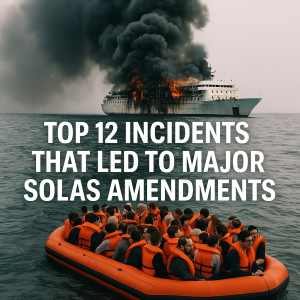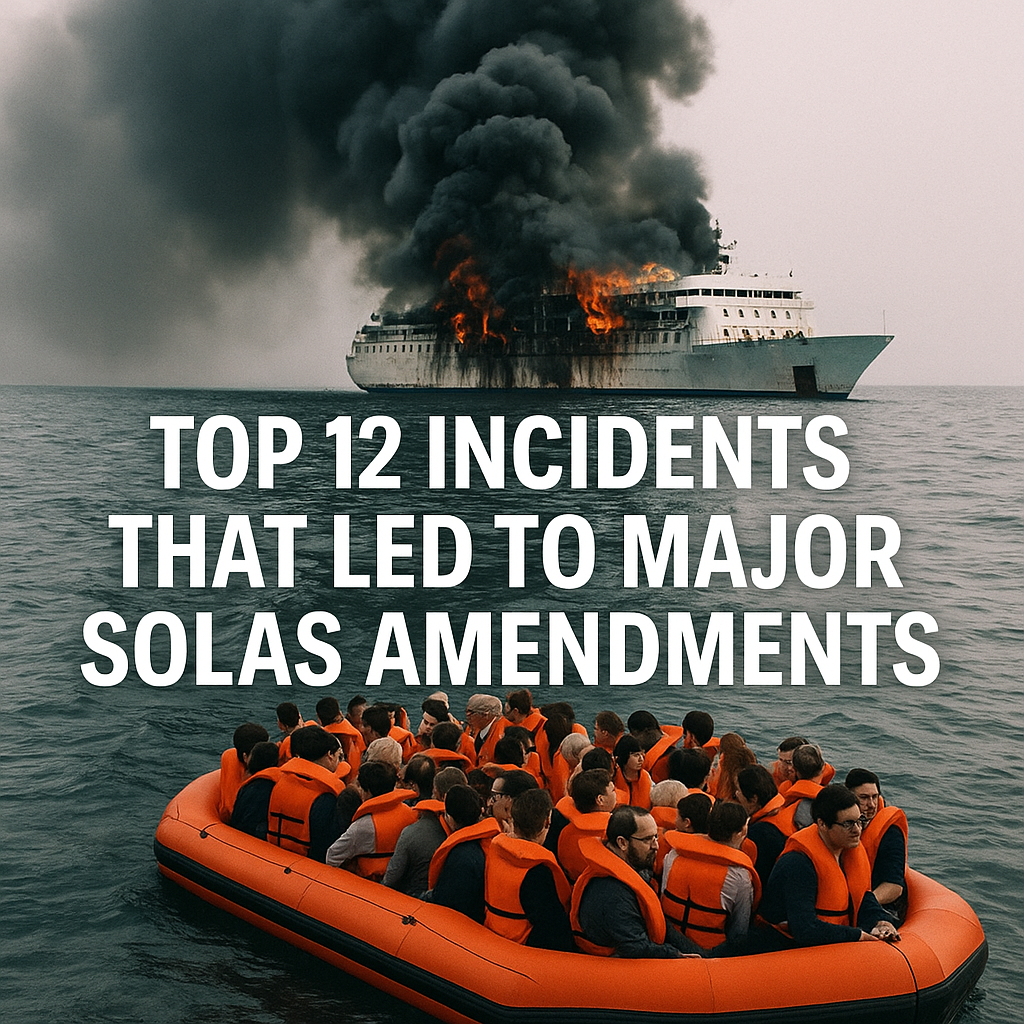
Explore the 12 most significant maritime disasters that reshaped the SOLAS Convention. From the Titanic to modern ferry tragedies, discover how each incident changed international ship safety forever.
Tragedy as a Teacher at Sea 🚢
Maritime history is written not only in voyages of discovery and global trade but also in tragedies that cost lives and changed laws. For every breakthrough in navigation, engineering, and communication, there are painful stories where the sea reminded humanity of its power.
Among the most important legacies of maritime safety is the International Convention for the Safety of Life at Sea (SOLAS), first adopted in 1914 after the sinking of the Titanic. Today, SOLAS is often called the “Bible of ship safety.” It has been revised many times, each amendment often triggered by disasters that exposed flaws in ship design, operation, or regulation.
This article explores the 12 major incidents that led to pivotal amendments in SOLAS—tracing how tragedy shaped rules that now protect millions of seafarers and passengers worldwide.
Why SOLAS Matters in Modern Maritime Operations
The oceans remain unforgiving, and shipping is still one of the most complex industries on Earth. Despite advanced technology, accidents happen—fires, collisions, capsizing, or equipment failures. Each disaster leads to investigations, reports from authorities like the IMO, MAIB, or Paris MoU, and in many cases, new global safety regulations. Understanding the link between accidents and amendments is crucial for:
- Maritime professionals, who must apply lessons learned in daily operations.
- Students and cadets, building awareness of why certain safety drills and equipment exist.
- Regulators and policymakers, ensuring the industry never repeats the same mistakes.
–
1. RMS Titanic (1912) – Birth of SOLAS
No shipwreck shaped maritime law more than the Titanic. On 14 April 1912, the supposedly “unsinkable” liner struck an iceberg and sank in the North Atlantic, killing over 1,500 people.
What went wrong:
-
Inadequate lifeboats (only enough for about half the passengers).
-
Lack of continuous radio watch (distress calls were delayed).
-
Poor iceberg reporting system.
SOLAS Response (1914):
-
Mandatory lifeboats and life-saving appliances for all passengers and crew.
-
Continuous radio communications on all passenger ships.
-
Creation of the International Ice Patrol to monitor iceberg danger zones.
2. SS Morro Castle (1934) – Fire Safety at Sea
In 1934, a fire broke out on the U.S. passenger liner Morro Castle off New Jersey. Within hours, the ship was engulfed in flames; 137 lives were lost.
Issues exposed:
-
Flammable interior materials.
-
Crew poorly trained in firefighting.
-
Ineffective fire suppression systems.
SOLAS Amendments (1948):
-
Fire-retardant construction materials mandatory.
-
Enhanced fire detection and suppression systems.
-
Crew training in firefighting drills became compulsory.
3. SS Andrea Doria vs. MS Stockholm (1956) – Collision Regulations
The Andrea Doria, a luxury Italian liner, collided with the Swedish ship Stockholm off Nantucket, resulting in 46 deaths.
Causes:
-
Miscommunication in radar interpretation.
-
Human error in navigation.
SOLAS Amendments (1960):
-
Improved radar standards on ships.
-
Emphasis on radar training for officers.
-
Development of the International Regulations for Preventing Collisions at Sea (COLREGs, 1972), closely linked with SOLAS.
4. SS Yarmouth Castle (1965) – The Catalyst for Fire Rules
When fire consumed the cruise ship Yarmouth Castle in the Bahamas, 88 lives were lost. Passengers were trapped because the fire spread rapidly through wooden interiors.
SOLAS Amendments (1966 & 1974):
-
Passenger ships required to use non-combustible materials.
-
Strict rules for fire-resistant bulkheads and escape routes.
-
Regular fire drills for crew and passengers.
5. SS Edmund Fitzgerald (1975) – Bulk Carrier Stability
The Edmund Fitzgerald, a giant Great Lakes ore carrier, sank during a storm, killing all 29 crew.
Contributing factors:
-
Inadequate freeboard and stability issues.
-
Lack of real-time wave and weather forecasting for inland waters.
SOLAS/IMO Response:
-
Reinforced bulk carrier design and hatch cover standards.
-
Weather routing systems integrated into voyage planning requirements.
6. MV Herald of Free Enterprise (1987) – Ro-Ro Ferry Tragedy
A roll-on/roll-off ferry capsized minutes after leaving Zeebrugge, Belgium, killing 193 people.
Root cause:
-
Bow doors left open; water flooded the car deck.
-
Poor safety culture and lack of procedural checks.
SOLAS Amendments (1988–1990):
-
Requirements for water-tight doors and indicators on the bridge.
-
Enhanced stability standards for Ro-Ro passenger ships.
-
ISM Code (International Safety Management) later strengthened after this and similar incidents.
7. Scandinavian Star (1990) – Fire and Evacuation Failures
A fire broke out on the Scandinavian Star ferry, killing 159 passengers.
Safety issues:
-
Inadequate fire detection systems.
-
Confusing evacuation routes.
-
Crew unprepared for crisis.
SOLAS Response:
-
Mandatory smoke detectors in all accommodation spaces.
-
Clear, illuminated evacuation signage.
-
Lifesaving appliance standards upgraded (lifejackets, muster stations).
8. Estonia Ferry Disaster (1994) – The Baltic Sea’s Darkest Night
The Estonia capsized in rough seas, killing 852 people. It remains one of the deadliest peacetime maritime disasters.
Causes:
-
Bow visor failure, flooding the car deck.
-
Lack of structural redundancy.
SOLAS Amendments (1995):
-
Stricter Ro-Ro ferry construction standards.
-
Evacuation analysis requirements for passenger ships.
-
Voyage Data Recorders (VDRs, or “black boxes”) mandated.
9. MT Erika Oil Spill (1999) – Structural Integrity of Tankers
The Erika, a Maltese-flagged tanker, broke apart off France, spilling 20,000 tonnes of oil.
Causes:
-
Structural failure due to corrosion.
-
Inadequate inspection regimes.
SOLAS and IMO Response:
-
Accelerated phase-out of single-hull tankers.
-
Enhanced survey program for aging ships.
-
Stronger classification society oversight.
10. Costa Concordia (2012) – Human Factors
When the Costa Concordia struck rocks off Italy, 32 lives were lost.
Investigations found:
-
Unsafe deviation from planned route.
-
Crew disorganization during evacuation.
SOLAS Amendments (2013+):
-
Mandatory passenger safety drills before departure.
-
Stricter bridge resource management (BRM) requirements.
-
Emphasis on safety culture under ISM Code.
11. Sewol Ferry Disaster (2014) – Overloading and Evacuation
The South Korean ferry Sewol capsized, killing over 300 passengers, mostly students.
Root causes:
-
Overloaded cargo.
-
Poor stability due to modifications.
-
Inadequate evacuation orders.
SOLAS/IMO Lessons:
-
Reinforcement of cargo securing and stability calculations.
-
Greater focus on passenger safety management.
12. Norman Atlantic (2014) – Fire at Sea in the Adriatic
A fire broke out on the Norman Atlantic ferry en route to Italy, killing 31 people.
Failures:
-
Inadequate fire containment.
-
Lifeboats and evacuation systems malfunctioned.
SOLAS Amendments:
-
Strengthened rules on firefighting systems in Ro-Ro spaces.
-
Enhanced evacuation procedures for ferries operating in enclosed seas.
–
Case Studies: How SOLAS Keeps Evolving
-
Amendments of 1974 (Consolidated Convention): Introduced a framework for continuous amendments without new conventions each time.
-
Post-9/11 Security Amendments (2002): ISPS Code added under SOLAS to address terrorism risks.
-
Polar Code (2017): Adopted under SOLAS for ships in Arctic/Antarctic routes.
Challenges in Enforcing SOLAS
Enforcing SOLAS faces several persistent challenges, including the use of Flags of Convenience where some states lack the resources for strict oversight. The human factor also remains critical, as negligence or inadequate training can undermine even the most robust rules. Furthermore, smaller operators often face significant technology gaps, struggling to afford the costly new equipment required for compliance. In short:
- Flags of Convenience: Some flag states lack strict enforcement capacity.
- Human Factor: Even with rules, negligence or poor training undermines compliance.
- Technology Gaps: Smaller operators struggle to meet costly new requirements.
Future Outlook
- Cybersecurity requirements for ship systems.
- Green fuel safety (LNG, ammonia, hydrogen).
- Autonomous vessel standards.
Just as Titanic reshaped lifeboat rules, the next disaster—if lessons are ignored—could rewrite the future of maritime safety.
Frequently Asked Questions (FAQ)
1. What is SOLAS in simple terms?
It is an international treaty that sets minimum safety standards for the construction, equipment, and operation of ships.
2. How many versions of SOLAS exist?
The original (1914) and subsequent versions in 1929, 1948, 1960, and 1974 (the current consolidated convention).
3. Which was the deadliest incident leading to SOLAS changes?
The Estonia ferry disaster (1994) remains one of the deadliest, alongside the Titanic.
4. Who enforces SOLAS?
Flag states and Port State Control regimes like Paris MoU, Tokyo MoU, and USCG.
5. Are SOLAS rules the same for all ships?
They apply mainly to commercial ships on international voyages. Some domestic or smaller vessels may follow national rules.
6. What happens if a ship violates SOLAS?
Possible detention, fines, withdrawal of certification, and loss of insurance coverage.
Conclusion: Learning from Losses 🌍
The 12 incidents outlined here remind us that maritime safety evolves from tragedy. Each fire, collision, or capsizing forced the international community to act—ensuring future generations of seafarers and passengers are safer.
The sea remains unpredictable, but SOLAS proves that humanity can adapt, legislate, and innovate. The challenge is to keep safety culture alive not just in codes and books, but in every officer’s decision and every seafarer’s daily practice.

